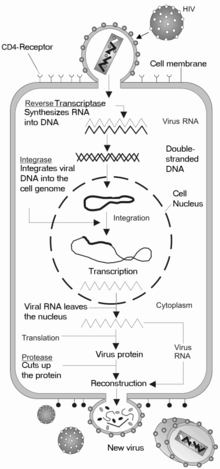Tissue tropism
Tissue tropism is the cells and tissues of a host which support growth of a particular virus or bacteria. Some bacteria and viruses have a broad tissue tropism and can infect many types of cells and tissues. Other viruses may infect primarily a single tissue. For example rabies virus affects primarily neuronal tissue.
Influencing factors
Factors influencing viral tissue tropism include:
- The presence of cellular receptors permitting viral entry.
- Availability of transcription factors involved in viral replication.
- The molecular nature of the viral tropogen.
The cellular receptors are the proteins found on a cell or viral surface. These receptors are like keys allowing the viral cell to fuse with a cell, or attach itself to a cell. The way that these proteins are acquired is through similar process to that of an infection cycle.
How 'tropic' tissue is acquired

Tissue tropism develops in the following stages:
- Virus with GPX enters body (where GP - glycoprotein and X is the numeric value given to the GP)
- Viral Cell 'targets' cell with a GPX receptors
- Viral Cell fuses with the cell and inserts its contents into it
- Reverse Transcription occurs
- Viral DNA is incorporated with host DNA via Viral Enzyme
- Production of RNA and Viral Protein
- Viral particle is assembled
- Viral particle buds out of the cell taking a chunk of the cell membrane with it acquiring a new tissue with all the receptors it needs to continue Tissue Tropism
Example: HIV has a gp120 which is precisely what the CD4 marker is on the surface of the macrophages and T cells, thus HIV can enter T cells and macrophages
See also
References
- Raven, Peter H.(2008). "Biology 8th Edition". New York, McGraw-Hill.